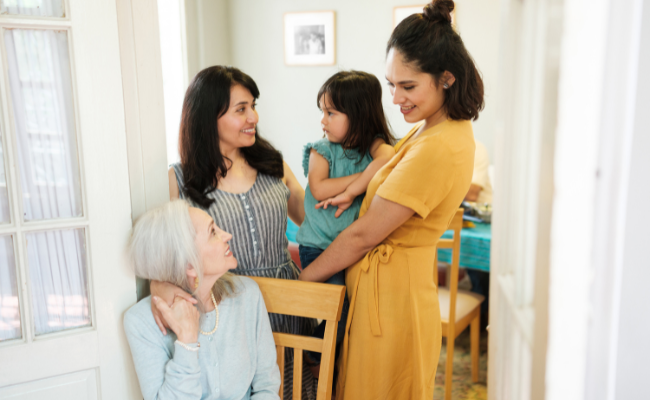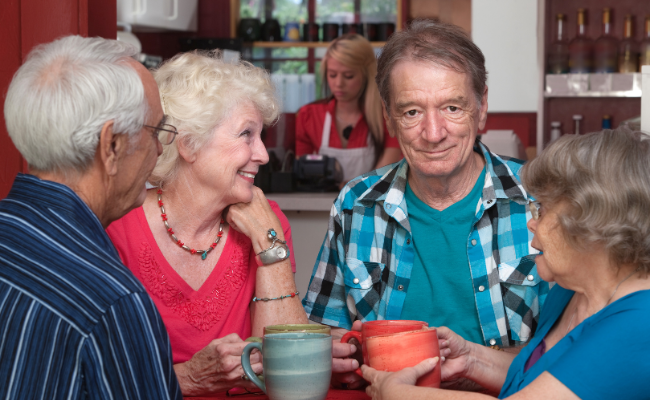The Sandwich Generation, Aging, and Community with Shain Khoja
“When you are caregiving, it’s very much like being in an airplane: you need to put on your own oxygen mask first, and then you can help others.” – Shain Khoja
I sat down with Shain Khoja, a global changemaker and serial entrepreneur. One of her crowning achievements was leveraging the technology to create a telemedicine system in Afghanistan, enabling hospitals to train doctors and nurses and tap the expertise of medical experts outside the country.
She is in the throes of developing Thriving.ai, a digital platform to keep seniors connected and engaged with their families and caregivers.
We discuss:
- The Sandwich Generation and the social implications of caregiving needs
- The value of intergenerational connection and healthy aging
- How Thriving.ai facilitates communication, connection, and learning in caregiving
The Sandwich Generation and the social implications of caregiving needs

Typically, people between the ages of 35 and 65 focus on looking after children and elderly parents, a “Sandwich Generation” that has stakes on both sides of the spectrum—raising kids and elderly care. 12% of the Sandwich Generation are over the age of 72, and the younger millennials make up 19%.
“What's so interesting about this is that while this is a specific problem, it has huge, wider societal issues.” Shain explains, “Caregiving is coming upon individuals at the peak of their careers, either a growth peak, or actual peak, and one in three individuals are having to leave the workforce, which is costing employers an excess of $38.6 billion a year.”
In addition to that, if we’re juggling at both ends—kids and elderly parents—and are not able to maintain financial resilience, it impacts our future as well. When our energy is tied-up in caregiving, every aspect of life feels the effects.
This dilemma is part of why Shain and her team are developing an application to assist care receivers and caregivers, starting with a check-in function.
“You'd be in an office meeting or running a meeting, and the phone rings, right? And you can see it's mum. Now, if you stop and answer it, you become that employee that's looking after her mum, that's always stopping meetings.” Shain explains, “And if you ignore it, then 10% of your brain is elsewhere.”
With Thriving.ai, we can see the status of whoever is calling. Red is urgent, and amber or green is neutral, providing peace of mind. “We built this with pain points in mind, and consulted users so that we were building something they could use and find really helpful.” Shain continues.
The value of intergenerational connection and healthy aging

When was the last time you sat down with your grandmother or an elderly neighbor and listened? What about someone younger than you?
Connecting across multiple generations can lead to insights and revelations we’d never think of otherwise. The siloed Western world often loses this aspect of community and with it, the chance for increased healing and growth.
“We're living in a rapidly aging world globally.” Shain shares, “Already, there are almost 1 billion people over 60. And this is going to rise to 2.1 billion by 2050. The fact that we're living longer is a huge achievement, but it's not about the quantity of life, it's about quality of life.”
90% of older adults want to age peacefully at home, not in institutions or hospitals. Yet 52% of older adults 65 and above have two or three comorbidities from respiratory illnesses, diabetes, cardiovascular osteoarthritis, and beyond. This commonality means that the majority of the elderly will end up in the very facilities they wish to avoid.
“There seems to be a focus on youth that is unequal. The knowledge and reminiscence of older adults are fascinating.” Shain shares, “We did an experiment on this where we invited older adults and younger adults—adults between the ages of 20 and 35—and we matched them with adults 60 and above. We put 10 topics up on the wall, and we asked them to pick three that they wanted to talk about.”
Each pair had a 15-minute conversation. For seven minutes, they discussed the topic they chose, and with the remaining time, they slipped into a more intimate discussion unprompted.
“On the debrief at the end, the older people said, ‘I didn't know my knowledge could help younger people so much, I want to do more of this and give back.’ And younger people said, ‘It was lovely to speak to another individual, as old as my grandma, to actually understand life stories, life learnings, and how to interact with an older adult.’” Shain continues.
There is endless untapped value in intergenerational connections. We need only to look around and recognize the opportunities.
How Thriving.ai facilitates communication, connection, and learning in caregiving

It is a proven science that the more engaged and included older adults are, the healthier they live. It does not have to be complicated or expensive to provide those environments.
“A lot of individuals think that technology can replace human contact,” Shain points out, “I don't believe that's the right way. I believe that technology can assist us to do better, to increase interactions, and help ease some of the stresses of everyday life so that you can focus on the content of your interaction.”
The world is beautiful, and the benefits of being in nature do not diminish with age. If anything, they increase. The lack of mobility in old age tends to create isolation and loneliness, a cut-off existence that includes even basic joys like strolling through a park or along the beach.
“One thing about Thriving.ai is to deal with the coordination and complexity of care, but on the other side, there's the issue of connection, communication, learning—these are all things that everyone involved in care can benefit from.” Shain explains, “Within the app, we very quickly realized that older adults want to learn new things, and so we have something called learning journeys, where individuals can go and do a 30-minute or a 45-minute learning schedule.”
These learning journeys can be anything from gardening to painting to meditation. And soon, Shain and her team are introducing skill swaps in the coming year, where generations can connect over special interests.
Within the app, there's the ability to access resources for caregivers, as well—often around how to take a break and engage your employer so they can gain support from some of the employer's benefits available today.
Where do you see the future of elder care going in the next few years? Do you have experience caring for a loved one into old age?
Be sure to check out Shain’s full episode for further insight on caregiving and intergenerational connection, and learn more at Thriving.ai!








